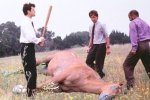Sorry, you're wrong. Read what I've written - it's all there. And take care to read what's there, not what you're making up (i.e., "there are no kegs, taps, or any other yada yada yada" in response to me saying "There are ~30 beer cashiers at TCF Bank stadium, ready to do business with anyone of age.")
Others who were near or at the pretty concession stands setup to sell beer today may be able to verify that in the West Plaza area alone there were 24 cashiers machines operating - 6 per tent x 4 tents. I counted them with my own eyes, partner.
You've accepted the "begrudging... with their focus on the highest chance of keeping alcohol out of student's hands" line of thinking, whereas I'll tell you they flip flopped because of ticket sales. We can disagree on that. I wonder what you'll say, though, when they start selling at more than 2 locations and get closer and closer to the student section...
I'll say it's an obvious move and should have been done today. Having alcohol sold a 2 minute walk away from the student section didn't keep beer and wine away from students today - but at least you feel good about making them walk a couple hundred yards for it.
Well I can tell you the April 2012 legislation absolutely did change the verbiage of the ruling "alcohol for all or none" to "alcohol for all in a 'convenient' location, even if it's only one spot along with in premium seating, or none at all." In addition it also clarified the ability of the U to do so in Mariucci and Williams Arenas. So yes, the recent legislation did exactly what station19 said.
By your logic, they could have done this alcohol move a year ago due to sagging sales. Remember, Kill also walked around campus passing out free tickets to students. The previous season had also been 3-9 with B10 wins over only Iowa and Illinois. Interest was low, early attendance confirmed, especially with embarrassing losses to NDSU and New Mexico St. Yet they didn't, and I wonder why?
If you don't think distance is a deterrent to people eating or consuming things, I can't help you. Go read some studies proving how much more likely people are to eat candy or drink soda if it's within arm's reach, and how there is a similar but lower multiplier for if those things are within easy walking distance. Furthermore, you think walking up the stands and around the entire stadium (roughly 200 yds as you state) takes 2 minutes? I posted in another thread the experience of my friend who was in the student section with me. The worst part of his journey was the walk to and from, as he explicitly stated to me. Carrying the booze back in your hands has a high chance of spills. Although I have regular season tickets I met up with my sister and some of my friends down in the student section halfway through the second quarter and can confirm I saw 3 beers total - all of which in my 27 year old friend's hands. I obviously did not pass through the entire student section, but I can tell you that there was FAR, FAR less beer present than when I attended games in the Dome student section in 2007-2008. And I'm pretty attentive to most things like that.
You refuse to accept that the U did many things to keep up with their principles while fighting a public perception and market desire nightmare situation. The location of the garden opposite the student section and the fact that beer sales ended at halftime (rather than end of 3rd quarter like the Dome and most venues) prove this to me. The U is in the unfortunate position of being one of the few big time college football programs in a top 20 population/media market that has all 4 pro sports teams (name me 5 other schools with this situation?). Yes, they did bend on selling in the general seating "area" to gain the revenue from the suites to compete for fan and business attention and loyalty, something schools like Iowa, Wisconsin, and Illinois don't have to do.
If, in 2 years, the U begins selling beer at ever concession stand along the concourse, I will eat crow. However, I guarantee they will only do this if they get continued negative press (ie, 3 years similar to the ragging they got over this original alcohol issue) about the "loooong beer lines" and "extreme inconvenience for fans near the bowl end" from the many media outlets. I wouldn't be surprised but would still be disappointed that the only venue in the B10 where one can buy beer gets more negative press than anyone else does.


